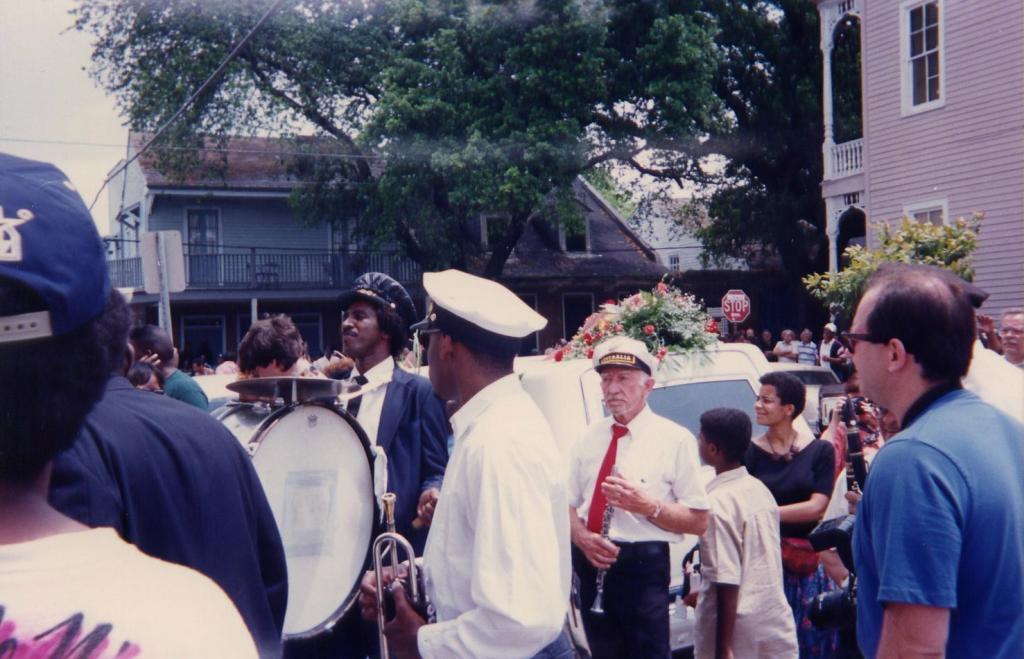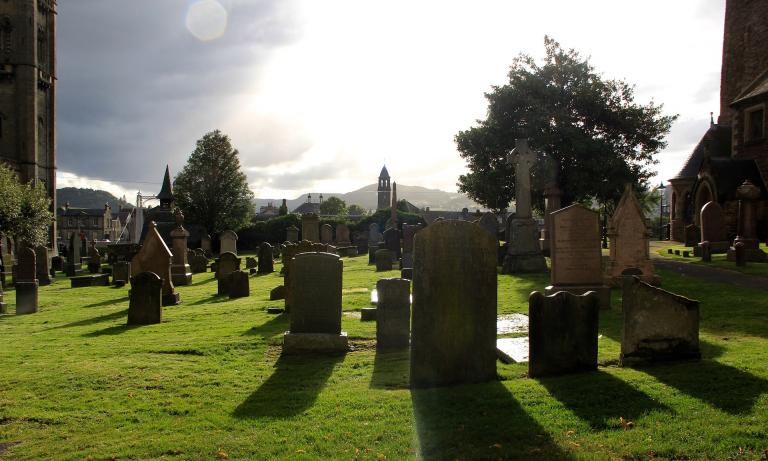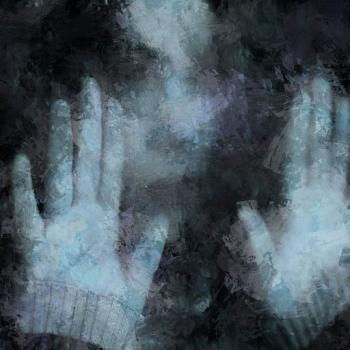In November I turned 50 and for this momentous occasion I travelled to New Orleans for the first time. I saw and experienced so many incredible things that will forever live in my memory. However, one of the experiences that stands out the most is one that I had not anticipated or planned for.
I was lying in my hotel room after a pretty eventful day, not paying much attention to the activity outside. (The hotel was in the French Quarter on a main street so it was not uncommon to hear noises outside throughout the day and night.) I thought I heard jazz music further away and just assumed there was a concert going on somewhere.

The jubilant sounds of a band playing “When the Saints Go Marching In” continued to get closer and closer, until I finally peeked out my window to see a jazz funeral procession in full swing. There, walking down the street, was a woman in a wedding dress holding a parasol and dancing her way to the next intersection. She was led in the procession by police and was followed by what seemed to be an endless stream of people of all walks of life smiling and celebrating in the midst of their grief.
I started thinking about the power in taking what is normally a very mournful occasion and adding to it an element of life-affirming celebration. My thoughts quickly moved to the non-tangible little deaths that we all experience. In particular, I thought about all of the times I had tried to let go of someone or something that no longer served me.
There have been so many times when I recognized aspects of myself – shadow behaviors and choices – that were no longer in my best interest. Each time, I would emphatically state to myself out loud that I was letting these things go and filling the void with something better.

In more cases than I would like to admit, my pure stubbornness kept me on the new and better track for a little while but inevitably I would find myself slipping back into the comfortable caress of my shadow. When I looked at why so many of these efforts fail to take hold (both my efforts and the efforts of others) and compared these acts of letting go to a traditional jazz funeral, I found something very intriguing. While intent and desire are good and necessary, a jazz funeral addresses two elements that these previous efforts had overlooked – the importance of physical, tangible representation, and the power of transitions.
As explained to me by a New Orleans native, a jazz funeral has three components. The first procession is the one that leads to the cemetery. This procession is comprised of family members and close friends of the deceased and is accompanied by somber music. It is not uncommon to witness members of the procession openly grieving and weeping as they make their way to their destination. Once the mourners have reached the cemetery, a service of some kind is held which could include but does not necessitate a traditional burial.

Upon completion of the service, the processional begins to make its way back to the starting point. However, unlike the first processional, this one is lively, with upbeat music played by a band and mourners freely dancing their way through the streets if they so choose. Anyone who knew the deceased in any capacity is welcome to join this processional, for it is a celebration of the one that has been lost. It is a joyful remembrance of all the ways in which this person left his or her mark on the world and their lives.
The physicality of this entire funeral is markedly different from most traditional funerals. This is one of the components that makes the jazz funeral so powerful. Trauma – particularly childhood and/or repeated trauma – is the seed that creates unhealthy patterns and it is the force which nurtures our shadow selves. Oftentimes the things that we are trying to let go of because they no longer serve us are the same habits, behaviors, and/or form of thinking that helped us to effectively cope and possibly even survive at an earlier time in our lives.

According to Resmaa Menakem, author of My Grandmother’s Hands, trauma not only leaves its mark on our emotional, mental, and spiritual selves, it also ingrains itself in our physical bodies. When we are faced with trauma, our bodies automatically go into fight, flight or freeze mode – all of which bypass the thinking mind.
After a while when we are triggered in ways reminiscent of trauma we have experienced, we can automatically fall back into these old patterns without even thinking about it. This can occur even when we feel that we have long ago released and/or healed our shadow selves. Furthermore, studies have shown that trauma can be passed down through generation after generation through our DNA. Adding a physical component to our spiritual work of letting go and healing the shadow self can help us to address the physical marks of trauma that still reside in our bodies without our knowledge or awareness.
Another powerful component of the jazz funeral is the marked transitions inherent in this ritual. A few years ago, I was attending a leadership development institute which focused in part on change management. One of the things that resonated with me was the instructor’s comment that it’s not the change that’s difficult, it’s the transitions (or lack thereof).
We often jump from the old to the new without taking time for reflection, for grieving the past and for considering how our future will be different. Rarely do we break down into small, manageable steps how we will move on the continuum from the old to the new. We may announce to the universe what it is we wish to release and what we wish to fill the void, but how often do we intentionally fill in the gap between the two?

The jazz funeral has very clear-cut transitions which facilitate an outlet for grieving what has been lost; a physical release of the loved one through actions such as burial, and a celebration of the gifts left behind by that which has been released. This joy inherent in this last processional is also life affirming and allows us the freedom to step into our future. I have found that using the framework of the jazz funeral can be very effective in helping me to truly let go of that which no longer serves me in a way that “sticks”. If you are interested in trying this concept, the following sample outline for a shadow funeral can be found below.
The Mourning
Take some time in a quiet place where you won’t be disturbed. Ground yourself and clear your mind in a way that works best for you. Once you are ready, create a physical representation of what you wish to let go (i.e. a collage, a drawing, or a word written on a piece of paper).
Think about what led you to that behavior/shadow and how it once served you. Next, think about in what ways the behavior or pattern no longer serves you and may even be causing you pain. Finally, think about the reasons you may have been reluctant to truly let go of or heal this aspect of your shadow self.
For example, in order to cope with trauma as a child, you might have withdrawn into yourself. Perhaps you created walls to shut anything negative out and/or you pretended like things were fine when they weren’t. At that time in your life, this may have been the only way you could cope.
As you grew older, you may have found that shutting people out has cost you relationships that could have brought you joy. It may be that by pretending things were ok when they weren’t, small problems snowballed until they were overwhelming and the consequences were significant.
While you may acknowledge that you need to heal and let go of these behaviors in order to achieve greater happiness, the fear of allowing yourself to be vulnerable and exposing yourself to pain and rejection could be what keeps you returning to these patterns. Acknowledging this out loud can help you to move forward.

Physicality is a key piece of this rite just as it is in the jazz funeral. This physicality is enacted at this stage in your mourning. When I say mourning, I mean really mourning, with no holding back. Scream, cry, keen – whatever it takes to fully experience your grief at having to let go of this aspect of yourself.
When you feel your mourning is complete, it is time to release that which no longer serves you. This can be accomplished by burying or burning the physical representation of that which you are letting go.
If you have a flair for the dramatic, you might want to try author Amy Blackthorn’s tip which is to create or write your physical representation on flash paper that you can find at magic stores or online. When you burn flash paper, there is nothing left behind and this symbolism can be quite effective.
Finally, it is time to celebrate. The intent here is to celebrate the ways in which what you have let go once served or helped you. Express your gratitude for this and begin to envision your future now that you are free of this aspect of your shadow. Think about the baby steps that must occur to realize this vision of the future. In order to enact the physical for this part of the rite, you can sing, dance, create art, or do an act of self care. Whatever you choose to do, it should feel good and be life affirming in some way.
By allowing ourselves to fully experience all of the emotions and transitions sparked by what we have lost and/or are choosing to give up, we can find the beauty and power inherent in the act of letting go.














